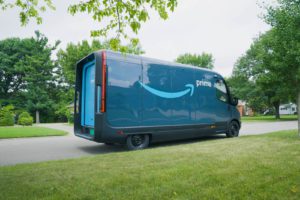
Paul A. Eisenstein is publisher and editor-in-chief of The Detroit Bureau.
You might not hear the delivery van pull up next time Amazon Prime delivers your package.
That’s because the online retail giant has formally launched service using the first of what eventually will be 100,000 all-electric delivery trucks custom-built by EV startup Rivian.
While it’s been testing Rivian prototypes for more than a year, Amazon announced it formally launched operations Thursday using the trucks in Baltimore, Chicago, Dallas, Kansas City, Nashville, Phoenix, San Diego, Seattle, St. Louis and some other markets. It will expand into 100 cities by year-end and then continue growing as it expands its EV fleet. It also has lined up a smaller order with Ram, the truck division of Euro-American automaker Stellantis.
Environmental advantages

Amazon is now using the first wave of all-electric delivery trucks it developed jointly with EV maker Rivian.
The move could help address some of the criticism Amazon Prime and competitors have faced. While American consumers have clearly embraced online shopping, the flood of delivery trucks roaming roadways spew a significant amount of global warming gases and other noxious emissions.
Calling the launch “a significant milestone,” Amazon CEO Andy Jassy said in a statement, “Fighting the effects of climate change requires constant innovation and action, and Amazon is partnering with companies who share our passion for inventing new ways to minimize our impact on the environment.”
Amazon first announced plans to purchase a small fleet of electric vans from Rivian in February 2019, soon afterwards expanding the order to 100,000 trucks to be delivered through 2030. It was a major step for the nascent EV maker, which had also started development on two retail product lines, the R1T pickup — for which it began deliveries last December — and the R1S sport-utility vehicle.
Amazon also announced plans to invest in the EV maker, along with a group of high-profile backers that included Ford Motor Co. Ford has since cut back its stake in Rivian, while also abandoning plans to jointly develop new products. It currently still holds about 86.9 million shares, for a 9.7% stake.
A big market for EV vans
Amazon is by no means the only company looking to migrate its delivery fleet away from internal combustion to electric drivetrain technology. A study released by market research firm BlueWeave Consulting last January forecast the global market for EV trucks had already reached $21.4 billion last year and would have a compound annual growth rate of 14.6% through the end of 2028, by then reaching $42.3 billion.
Meanwhile, a number of startups and legacy automakers are now battling for that business.
UPS and FedEx are also going electric. In fact, FedEx has already taken delivery of several vans from GM subsidiary BrightDrop. And the U.S. Post Office this past week buckled to criticism of an earlier truck replacement program that stayed with IC-powered trucks. It now plans to have 40% of its massive fleet go electric.
Rivian faces plenty of competition
Both Ford and General Motors have launched new EV truck subsidiaries and claim to have booked substantial orders. Mercedes, meanwhile, has inked a deal to provide its own battery vans to Amazon in Europe.
Walmart threw a lifeline to another EV newbie this month when it agreed to purchase 4,500 delivery vans from Canoo, while stating the deal could be expanded to 10,000 of the trucks. Just weeks earlier, Canoo warned investors it didn’t have enough cash to begin production, as planned, later this year.
For its part, Amazon said the new Rivian trucks not only will be more environmentally friendly but also should make the job easier and safer for its drivers. The vans will automatically lock as a driver goes to make a package drop-off, then reopen when they return. A powered, rather than manual, bulkhead door will make it easier to grab those packages. The outside doors have also been beefed up to better withstand a collision, and the cabin areas have been redesigned to improve ergonomics.
This article first appeared in The Detroit Bureau, an online source for news, reviews, spy shots, commentary, features, and guides about the auto industry. We repost it here with permission.